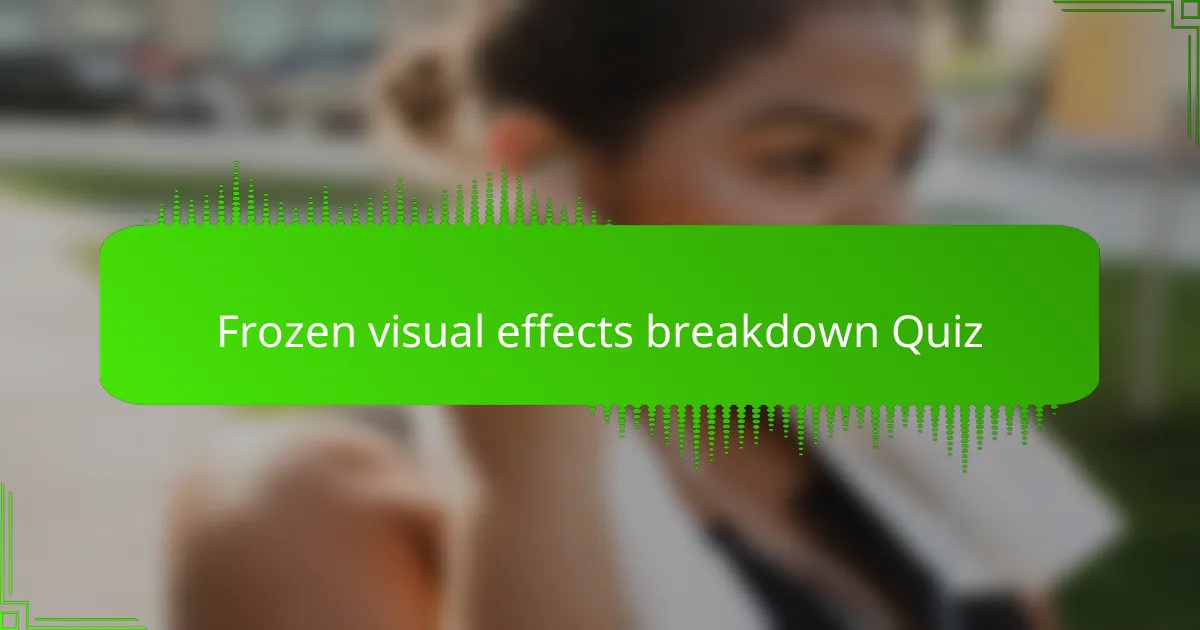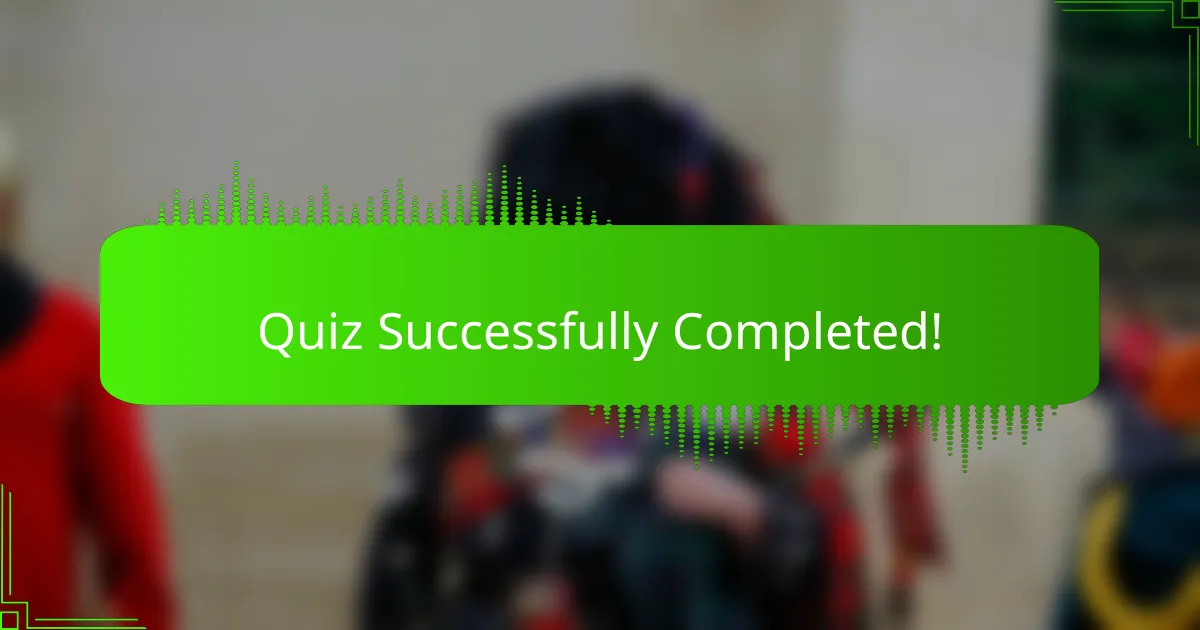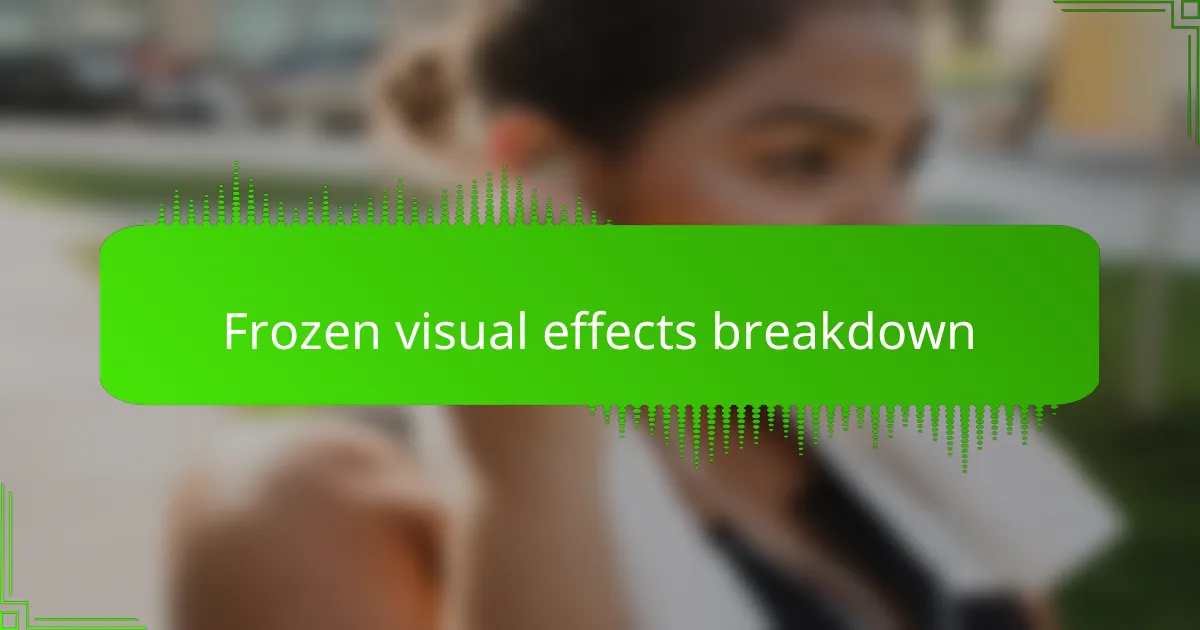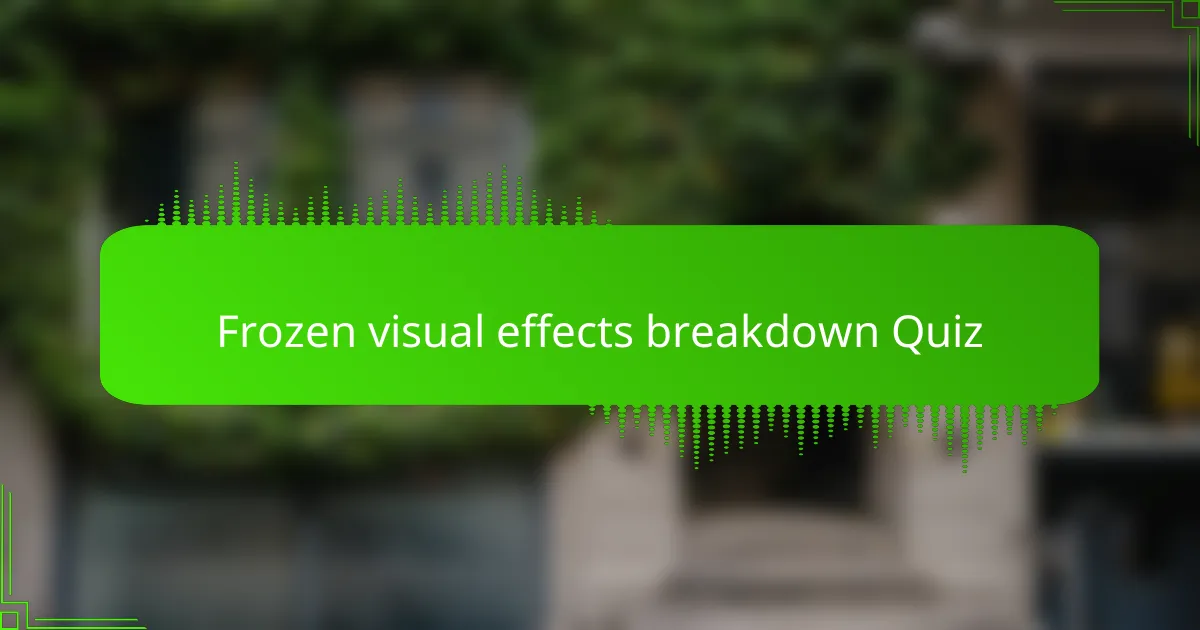
Frozen visual effects breakdown Quiz
1. What groundbreaking visual effect technique was used in Disney’s Frozen to replicate snow and ice?
- Particle animation
- Snowflake simulation
- Fire rendering
- Liquid simulation
2. How did Disney’s Frozen achieve realistic facial expressions through the use of advanced animation technology?
- Disney`s Frozen adopted motion capture technology used in live-action films.
- Disney`s Frozen utilized the Emotion Capture technology developed by Walt Disney Animation Studios.
- Disney`s Frozen implemented claymation methods for character facial animations.
- Disney`s Frozen relied on traditional hand-drawn animation techniques for facial expressions.
3. What character in Frozen was specifically designed to showcase cutting-edge hair simulation technology?
- Elsa
- Kristoff
- Anna
- Olaf
4. Which team at Disney Animation was credited with developing the complex ice simulation in Frozen?
- Laika Animation Company
- Disney Animation`s Effects Team
- DreamWorks Animation Studio
- Pixar`s Animation Team
5. What significant influence did the digital rendering of Elsa’s ice palace have on visual effects quality in animated films?
- It eliminated the need for voice actors in animated films.
- It set a new standard for realism in computer-generated elements.
- It introduced the first use of live-action integration in animation.
- It was the first use of motion capture for animated characters.
6. How did the visual effects in Frozen enhance the storytelling experience compared to Madonna’s music video visuals?
- The visual effects in Frozen created immersive snow and ice environments that deepened the emotional narrative.
- The special effects in Frozen highlighted character transformations and relationships, enhancing viewer connection.
- Madonna`s visuals often featured iconic fashion and choreography that supported her musical storytelling.
- Madonna`s music videos used bright colors and flashing lights to convey strong emotions and themes.
7. In what ways did Frozen’s visual effects team innovate lighting techniques to create the ambiance of a winter wonderland?
- They applied live-action filming techniques to create dynamic background elements.
- They utilized traditional 2D hand-drawn methods to enhance character expression.
- They developed a new physically-based rendering system to simulate realistic snow and ice lighting.
- They incorporated a unique pastel color palette to soften the overall visual tone.
8. What role did the development of character rigging play in bringing the protagonists of Frozen to life?
- Character rigging enabled the use of live-action footage as reference for animators.
- Character rigging allowed for more fluid and expressive movements in the protagonists of Frozen.
- Character rigging was primarily responsible for the film`s original musical score composition.
- Character rigging influenced the vocal performances of the actors in Frozen.
9. How did the animators use color grading in Frozen to reflect the emotional states of the characters?
- The animators used only black and white color grading to create a dramatic effect in Frozen.
- Color grading was applied uniformly across all scenes without consideration of character emotions.
- The color grading strictly followed a bright pastel palette to match the whimsical theme of the movie.
- Color grading was used to enhance the emotional impact of scenes, reflecting the characters` feelings through warm and cool tones.
10. What specific visual effects program was pivotal in creating the stunning environments seen in Frozen?
- Nuke
- Blender
- Autodesk Maya
- Adobe After Effects
11. How did the use of motion capture technology impact the animation process in Frozen compared to traditional methods used in Madonna’s videos?
- Traditional animation techniques were used in both Frozen and Madonna`s videos, ensuring consistency.
- Frozen`s animation relied solely on hand-drawn processes, similar to those used in Madonna`s videos.
- Madonna`s videos utilized motion capture as effectively as Frozen did in its character animation.
- Motion capture allowed for more realistic character movements in Frozen compared to Madonna`s animated videos.
12. Which visual effect in Frozen was noted for its ability to create a sense of scale and depth in the icy landscapes?
- Light Ray Simulation
- Motion Blur Effects
- Particle Effects
- Depth of Field
13. How did Frozen’s visual effects contribute to the award-winning status of its song “Let It Go”?
- The choreography of the snow creatures matched the rhythm of the song, creating a dynamic performance.
- A live performance of the song featured musicians from the cast, drawing attention away from the animation.
- The vibrant colors used in the animation established a cheerful backdrop that contrasted with the song`s theme.
- The stunning visuals of Elsa`s ice castle complemented the emotional weight of `Let It Go,` enhancing its impact.
14. Which aspect of Frozen’s animation contributed to its box office success following its adaptation into a musical element reminiscent of Madonna’s catalog?
- The reliance on traditional animation techniques
- The absence of musical numbers throughout the film
- The use of live-action sequences
- The incorporation of powerful vocal performances
15. In what ways did weather simulation technology used in Frozen set a new standard for animated films?
- It allowed for fully automated character animation without human input.
- It enabled real-time voice modulation for character expressions.
- The technology created realistic snow and ice effects that enhanced the visual storytelling.
- It provided an advanced soundtrack integration system for better music mixing.

Quiz Successfully Completed!
Congratulations on finishing the quiz about the fascinating world of Madonna’s music catalog! We hope you enjoyed the journey through her impactful body of work. By engaging with questions about her songs, albums, and cultural influence, you’ve likely discovered new insights about her artistry and legacy.
Throughout the quiz, many learners often find themselves deepening their understanding of not just Madonna’s music, but also the broader context of pop culture during her rise to fame. You may have explored the evolution of her sound or the themes she has tackled over the decades. Each of these elements contributes to her status as an iconic figure in the music industry.
We invite you to continue your exploration by checking out the next section on this page. Here, you will find more detailed information about Madonna’s music catalog, including comprehensive breakdowns of her best albums, iconic performances, and the visual and thematic elements of her work. Dive deeper and expand your knowledge even further!

Frozen visual effects breakdown
Overview of Visual Effects in ‘Frozen’
‘Frozen,’ produced by Walt Disney Animation Studios, is renowned for its groundbreaking visual effects. The film features stunning ice and snow simulations, which were crucial in creating the magical world of Arendelle. The visual effects team utilized advanced technology, including the proprietary simulation software called ‘Matterhorn,’ to achieve realistic snow and ice physics. This attention to detail contributed to the film’s critical acclaim and box office success, establishing it as a benchmark for animated films.
Impact of Visual Effects on ‘Frozen’ Soundtrack Integration
The visual effects in ‘Frozen’ significantly enhanced the storytelling of its soundtrack, particularly in songs like “Let It Go,” performed by Idina Menzel. The emotional weight of the visuals during this pivotal scene elevated the song’s impact. The combination of striking visuals and powerful music created a memorable experience, leading to the song’s commercial success. This integration showcases how visual effects can complement and amplify musical storytelling in film.
Collaboration Between Visual Effects and Music in ‘Frozen’
The collaboration between the visual effects team and music composers Kristen Anderson-Lopez and Robert Lopez was crucial in ‘Frozen.’ They worked closely to synchronize the animation with the emotional beats of the music. For example, the visual representation of Elsa’s powers during “Let It Go” directly aligns with the crescendo of the song. This synergy not only enhanced the narrative but also contributed to the film’s overall artistic achievement, resulting in numerous awards, including an Academy Award for Best Original Song.
What are the key visual effects techniques used in the movie Frozen?
The key visual effects techniques used in the movie Frozen include particle simulations, fluid dynamics, and 3D modeling. These techniques were essential in creating realistic snow, ice, and character movements. For instance, the snow effects were achieved using a proprietary simulation software called Presto, which allowed animators to create detailed snowflakes and ice formations that interacted naturally with the characters. The film’s success in visual effects won it the Academy Award for Best Animated Feature in 2014.
How did the visual effects team achieve the look of Elsa’s ice palace in Frozen?
The visual effects team achieved the look of Elsa’s ice palace by combining advanced modeling techniques with intricate lighting effects. They utilized a process called ray tracing to simulate how light interacts with ice, creating a shimmering, reflective quality. The team also employed a technique known as tessellation to add depth and detail to the ice structures. This attention to detail contributed to the palace’s stunning appearance, which became an iconic element of the film.
Where can one find a breakdown of the visual effects used in Frozen?
A breakdown of the visual effects used in Frozen can be found on various platforms, including YouTube and industry-related websites like Animation World Network. Many visual effects breakdown videos showcase the process behind the film’s stunning visuals, detailing specific techniques and software used. Additionally, the official Disney Animation website often features behind-the-scenes content that highlights the work of the visual effects team.
